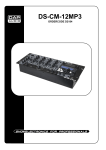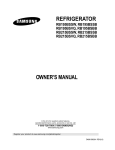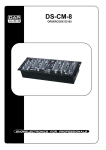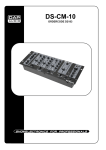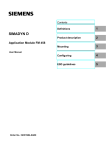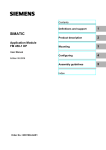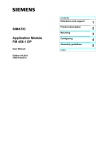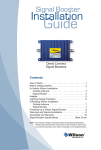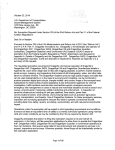Download DAPAudio DS-CDJ-250 Product specifications
Transcript
DS-CDJ-250 MKII V2 ORDERCODE D1226 Congratulations! You ha ve b o ug ht a g rea t, innova tive p rod uc t fro m DAP Aud io . The DAP Audio DS-CDJ-250 MKII brings excitement to any venue. Whether you want simple plug-&-play action or a sophisticated show, this product provides the effect you need. You can rely on DAP Audio, for more excellent audio products. We design and manufacture professional audio equipment for the entertainment industry. New products are being launched regularly. We work hard to keep you, our customer, satisfied. For more information: [email protected] You c a n g et som e of the b est q ua lity, b est p ric ed p rod uc ts on the m a rket from DAP Aud io . So next tim e, turn to DAP Aud io fo r m o re g rea t a ud io eq uipment. Always get the best -- w ith DAP Aud io ! Thank you! Dap Audio Dap Audio DS-CDJ- 250 MKII 2 2 2 Safety3 Operating Determinations Return Procedure....................................................................................................................................................4 Claims.......................................................................................................................................................................4 Warning .. Description...................................................................................................................................................................5 Overview.................................................................................................................................................................5 CD player................................................................................................................................................................6 Mixer.........................................................................................................................................................................7 Frontside..................................................................................................................................................................8 Backside..................................................................................................................................................................8 Installation....................................................................................................................................................................9 Set Up and Operation.................................................................................................................................................9 Names and functions..................................................................................................................................................9 CD player functions...............................................................................................................................................9 Mixer functions........................................................................................................................................................10 Front functions........................................................................................................................................................11 Back functions........................................................................................................................................................11 Operations...................................................................................................................................................................12 Opening and closing of the disc holder.............................................................................................................12 ..........................................................................................................................................................12 Selecting tracks using the FLD/TRK encoder.......................................................................................................12 Selecting Tracks using the Skip buttons...............................................................................................................12 Selecting folders.....................................................................................................................................................12 Starting playback...................................................................................................................................................12 Stop playback........................................................................................................................................................13 Pausing....................................................................................................................................................................13 Setting a cue point................................................................................................................................................13 Cueing.....................................................................................................................................................................13 Frame search..........................................................................................................................................................13 Scanning (fast forward/fast backward)................................................................................................................13 Time display............................................................................................................................................................14 Changing the p itch of the song...........................................................................................................................14 Program play..........................................................................................................................................................14 Loop play...............................................................................................................................................................14 Reloop.....................................................................................................................................................................14 Rep ea t....................................................................................................................................................................14 Setting the fader start relay..................................................................................................................................15 Crossfader replacement.......................................................................................................................................15 Before switching off the power..................................................................................................................................15 .........................................................................................................................................................................15 Precaution on storage..........................................................................................................................................15 Maintenance...............................................................................................................................................................16 Troubleshooting...........................................................................................................................................................16 Product Specifications................................................................................................................................................16 1 WARNING FOR YOUR OWN SAFETY, PLEASE READ THIS USER MANUAL CAREFULLY BEFORE YOUR INITIAL START-UP! Unpacking Instructions Immediately upon receiving this product, carefully unpack the carton and check the contents to ensure that all parts are present, and have been received in good condition. Notify the dealer immediately and retain packing material for inspection if any parts appear damaged from shipping or the carton itself shows signs of mishandling. Save the carton and all packing materials. In the event that a fixture must be returned to the factory, it is important that the fixture be returned in the original factory box and packing. Your shipment includes: -CDJ-250 MKII 2m WARNING CAUTION! Keep this system away from rain and moisture! SAFETY INSTRUCTIONS Every person involved with the installation, operation and maintenance of this system has to: be qualified follow the instructions of this manual - CAUTION! Be careful with your operations. With a dangerous voltage you can suffer a dangerous electric shock when touching the wires! Before you initial start-up , p lea se m a ke sure tha t there is no d a m a g e c a use d b y tra nsp o rta tion. Sho uld there be any, consult your dealer and do not use the system. To maintain perfect condition and to ensure a safe operation, it is absolutely necessary for the user to follow the safety instructions and warning notes written in this manual. Please consider that damages caused by manual modifications to the system are not subject to warranty. This system contains no user-serviceable parts. Refer servicing to qualified technicians only. IMPORTANT: The manufacturer will not accept liability for any resulting damages caused by the nonob serva nc e of this m a nua l or a ny una uthorized m od ific a tion to the system . Never let the power-cord come into contact with other cables! Handle the power-cord and all connections with the mains with particular caution! Never remove warning or informative labels from the unit. Never use anything to cover the ground contact. 2 Never leave any cables lying around. Do not insert objects into air vents. Do not connect this system to a dimmerpack. Do not open the device and do not modify the device. Do not drive the inputs with a signal level bigger, than required to drive the equipment to full output. Only use system indoor, avoid contact with water or other liquids. Avoid flames and do not put close to flammable liquids or gases. Always disconnect power from the mains, when system is not used. Only handle the power-cord by the plug. Never pull out the plug by tugging the power-cord. Always operate the unit with the AC ground wire connected to the electrical system ground. e cables. Make sure that the signals into the mixer are balanced, otherwise hum could be created. Make sure you use DI boxes to balance unbalanced signals; All incoming signals should be clear. Make sure that the available voltage is not higher than stated on the rear panel. Make sure that the power-cord is never crimped or damaged. Check the system and the powercord from time to time. Please turn off the power switch, when changing the power cord or signal cable, or select the input mode switch. Extreme frequency boosts in connection with a high input signal level may lead to overdriving your equipment. Should this occur, it is necessary to reduce the input signal level by using the INPUT control. to move its respective control upward; try lowering surrounding frequency ranges instead. This way, you avoid causing the next piece of equipment in your sound path to overdrive. You also preserve valuable dynamic reserve Avoid ground loops! Always be sure to connect the power amps and the mixing console to the same electrical circuit to ensure the same phase! If system is d rop p ed or struc k, d isc onnec t m a ins p o w er sup p ly im m e d ia tely. Ha ve a q ua lified engineer inspect for safety before operating. If the system has been exposed to drastic temperature fluctuation (e.g. after transportation), do not switch it on immediately. The arising condensation water might damage your system. Leave the system switched off until it has reached room temperature. If your Da p Aud io d evic e fa ils to w ork p rop erly, d isc ontinue use im m ed ia tely. Pa c k the unit sec urely (p refera b ly in the orig ina l p a c king m a teria l), a nd return it to your Da p Aud io d ea ler for service. Repairs, servicing and electric connection must be carried out by a qualified technician. For replacement use fuses of same type and rating only. WARRANTY: Till one year after date of purchase. OPERATING DETERMINATIONS This system is not designed for permanent operation. Consistent operation breaks will ensure that the system will serve you for a long time without defects. If this system is operated in any other way, than the one described in this manual, the product may suffer damages and the warranty becomes void. Any other operation may lead to dangers like short-circuit, burns, electric shock, etc. You endanger your own safety and the safety of others! Im p rop er insta lla tion c a n c a use serious d a m a g e to p eop le a nd p rop erty ! 3 Connection with the mains Connect the device to the mains with the power-plug. Always pay attention, that the right color cable is connected to the right place. International L N EU (including UK) From April 2004 Brown Blue Green/Yellow North America Pin Black White Green Phase Neutral Protective Earth Make sure that the device is always connected properly to earth! Return Procedure Returned merchandise must be sent prepaid and in the original packing, call tags will not be issued. Package must be clearly labeled with a Return Authorization Number (RMA number). Products returned without an RMA number will be refused. Highlite will not accept the returned goods or any responsibility. Call Highlite 0031-455667723 or mail [email protected] and request an RMA prior to shipping the fixture. Be prepared to provide the model number, serial number and a brief description of the cause for the return. Be sure to properly pack fixture, any shipping damage resulting from inadequate packaging is the customer p rod uc t(s). As a sug g estion, p rop er UPS p a c king or d o ub le -boxing is always a safe method to use. Note: If you are given an RMA number, please include the following information on a piece of paper inside the box: 1) Your name 2) Your address 3) Your phone number 4) A brief description of the symptoms Claims The client has the obligation to check the delivered goods immediately upon delivery for any shortcomings and/or visible defects, or perform this check after our announcement that the goods are at their disposal. Damage incurred in shipping is the responsibility of the shipper; therefore the damage must be reported to the carrier upon receipt of merchandise. It is the customer's responsibility to notify and submit claims with the shipper in the event that a fixture is damaged due to shipping. Transportation damage has to be reported to us within one day after receipt of the delivery. Any return shipment has to be made post-paid at all times. Return shipments must be accompanied with a letter defining the reason for return shipment. Non-prepaid return shipments will be refused, unless otherwise agreed in writing. Complaints against us must be made known in writing or by fax within 10 working days after receipt of the invoic e. After this p eriod c om p la ints w ill not b e ha nd led a nym o re . Complaints will only then be considered if the client has so far complied with all parts of the agreement, regardless of the agreement of which the obligation is resulting. 4 Description of the device Features The DS-CDJ-250 MKII is a DJ Workstation from DAP Aud io . Twin CD player with antishock LCD Display with blue backlight for fast control mm faders - card reader Overview Top Fig. 1 1. CD-player 1 2. Mixer 3. CD-player 2 5 CD-player Fig. 2 1) USB Slot 2) CD/USB/SD LED 3) CD/USB/SD Button 4) Loop In 5) FLD/ TRK Search Control 6) Loop Out 7) Reloop 8) Shuttle Wheel 9) LCD Display 10) Cue 11) Play/Pause 12) Time 13) Single 14) Program 15) Repeat 16) Direct Acces Buttons 17) B.Skip 18) Eject 19) + 10 (Track +10) 20) F.Skip 21) Pitch + 22) Pitch 23) Pitch 24) Fader 25) Jog Mode 6 Mixer Fig. 3 26) 27) 28) 29) 30) 31) 32) 33) 34) 35) Cue Selector Channel 1 Input Selector Cue Volume Channel 1Gain Channel 1 Mic Volume Channel 1High Master Volume Channel 1 Mid Channel 1 Low Channel 1 Fader 36) 37) 38) 39) 40) 41) 42) 43) 44) 7 Crossfader Channel 2 Input Selector Channel 2 Gain Channel 2 High Channel 2 Mid Channel 2 Low VU-Meter Channel 2 Fader Fader Start Relay Frontside Fig. 4 45) CD 1 Holder 46) SD 1 Slot 47) Microphone 48) Headphone 49) CD 2 Holder 50) SD 2 Slot Backside Fig. 5 51) 52) 53) 54) 55) 56) 57) 58) AC Power Fuse 500mA 250V Power ON/OFF 115V/230V Switch Headphone Master Balanced Out L/R Record RCA Unbalanced Out Master RCA Unbalanced Out 59) 60) 61) 62) 63) 64) 65) 66) 8 Channel 2 Level Selector Channel 2 RCA Input Channel 1 RCA input Channel 1 Level Selector GND Microphone XLR Balanced Input Microphone Jack Unbalanced Input Air Entrance Installation Remove all packing materials from the CD Player. Check that all foam and plastic padding is removed.. Connect all cables. Always disconnect from electric mains power supply before cleaning or servicing. Damages caused by non-observance are not subject to warranty. Set Up and Operation Before plugging the unit in, always make sure that the power supply matches the product specification voltage. The power supply is printed on the back of the device. Do not attempt to operate a 120V specification product on 230V power, or vice versa. Connections 1. Turn off the Power switch. 2. Connect the DS-CDJ-250 MKII to your amplifier using the proper cables. CAUTION: Be sure that the power is off, when connecting the cables. NAMES AND FUNCTIONS Below is a description of the functions of the controls. CD-player Functions 1. USB slot Allows the connection of a USB stick with a maximum capacity of 4Gb. 2. CD/USB/SD Indicate which source is selected for playback. 3. CD/USB/SD Button Use this button to switch between the CD player, the USB slot or the SD slot. Selection is indicated by the CD LED, the USB LED or the SD LED. 4. Loop IN: Press this button to set the startpoint of the loop. 5. FLD/TRK search control Depending on track or folder mode, you can use the encoder to select a certain track or folder. Confirm by pressing the encoder. 6. Loop OUT: Press this button to set the endpoint of the loop. 7. Reloop: This button is used to start the last saved loop. To finish the loop, press the Reloop button again. 8. Shuttle Wheel: In search mode the shuttle wheel can be used to search forward or backwards in the music track, as well as fine tuning the cue point in pause mode. In pitch bend mode the shuttle wheel will function the same as the pitch bend allowing you to speed up (forward) or slow down (rewind). In Scratch mode the shuttle wheel can be used for scrathing effects. 9. LCD Display 10. Cue: Press the Cue button during playback to return to the position at which playback is started. 11. Play/Pause-button : Use this button to start playback. Press once to start playback, twice to set the pause mode, press again to resume playback. 12. Time: Press this button to switch the Time-Display between the elapsed time and remaining time. The selected mod e is ind ic a ted b y the ELAPSED and REMAIN indicator on the LCD. 13. Single: Press this button to switch between the SINGLE and CONTINUOUS play mode. The selected mode is indicated on the LCD. In SINGLE mode, the unit stops playing after each track. In CONTINUOUS mode, the unit plays all tracks and then stops. 9 14. Program: Stop playback and press the Program Button. Now the player will enter the program mode. 15. Repeat: Use this button to repeat one track or all tracks of the selected medium (CD, USB-stick or SD-card). 16. Direct Acces Buttons: The direct acces buttons allow you to input a track number directly instead of having to skip through the tracks individualy. Just press the number or combination of numbers op to 99 and the player will jump to that track instantly. 17. B.Skip : Use this button to go back to the beginning of the current track or select a previous track for playback. 18. Eject: Press this button to open and close the disc holder. The disc holder cannot be opened during playback, stop playback before pressing the eject button. 19. +10 (Track + 10 Button): Use the button to skip forward 10 tracks. 20. F.Skip : Use this button to skip to the next track. 21. Pitch +: The CD speeds up as long as this button is pressed. Release the button to return to the original BPM. 22. Pitch: Pushing this button enables you to select a Pitch range (4/8/16). 23. Pitch : The CD slows down while this button is pressed. Release the button to return to the original BPM. 24. Pitch Fader: Use this fader to adjust the CD pitch. Slide up to decrease the pitch, slide down to increase the pitch. 25. Jogmode: When the jogmode button lights continuously, it indicates that the Shuttle Wheel is in search mode, when not illuminated it indicates the jog wheel is in pitch bend mode. Blinking of the jogmode button indicates that the Shuttle Wheel is in Scratch mode. Mixer Functions 26. Channel Cue Selector: This selector allows you to choose which channel you wish to monitor in your headphones, to the left is Channel 1 to the right is channel 2. 27. Chanel 1 Input Selector: Use this switch to choose which input will be controlled by that channels corresponding volume fader. For example the Channel 1 Input Selector allows you to choose b etween CD 1(The internal CDplayer), Line 1 which is the RCA 1 input, or Phono 2 (if the phono/ Line switch is set in Phono position). 28. Cue Volume: Is used to adjust your headphone monitor volume level. 29. Channel 1 Gain: Channel input level is determined by the Gain control. With the Gain control you can boost the signal of each individual channel. Ad just the input- sensitivity in order to match the incoming signals to the 30. Microphone Volume: Use to a d just the volum e of the m ic rop hone channel. 31 /33 /34. Channel 1 Equalizer Section (HI / MID / LOW): Use the 3 band equalizer to adjust the tone for each channel by using the HI, MID and LOW controls. 32. Master Level: Use to a d just the volum e o f the Master output. 35. Channel 1 Fader: The fader controls the volume of a single channel. The channel faders should be positioned within the range of -5dB to 0dB, leaving you with sufficient room to allow precise matching. 36. Crossfader: The crossfader allows you to mix evenly from one source to another. 37. Channel 2 input selector: Use this switch to choose which input will be controlled by that channels corresponding volume fader. 10 38. Channel 2 Gain: Channel input level is determined by the Gain control. With the Gain control you can boost the signal of each individual channel. Ad just the input- sensitivity in order to match the incoming signals to the 39 /40 /41. Channel 2 Equalizer SECTION (HI / MID / LOW): Use the 3 band equalizer to adjust the tone for each channel by using the HI, MID and LOW controls. 42. VU METER: The stereo VU Meter allows you to monitor the dB levels of the Left and Right Master output. 43. Channel 2 Fader: The fader controls the volume of a single channel. The channel faders should be positioned within the range of -5dB to 0dB, leaving you with sufficient room to allow precise matching. 44. Fader Start Relay: The Fader Start Relay function allows you to start CD playback simply by moving the Crossfader to a side. Front Functions 45. CD 1 Disc Holder Place the disc in the holder. Press the Eject button to open and close the disc holder. 46. Microphone 47. Headphone You can connect a pair of headphones with a minimum impedance of 32 Ohm to this stereo 1 jack should be wired as Tip=left, Ring=right and sleeve=ground. 48. CD 2 Disc Holder Place the disc in the holder. Press the Eject button to open and close the disc holder. 49. SD Card 1 Slot Slot for inserting SD/MMC c a rd . The c onta c ts of the c a rd m ust p oint d o w nw a rd s. The unit c a nnot rea d c a rd s w ith a c a p a c ity of m ore tha n 4GB. The unit is not c om p a tib le to SDHC c a rd s a nd only sup p orts the MP3 format. 50. SD Card 2 Slot Slot for inserting SD/MMC c a rd . The c onta c ts of the c a rd m ust p oint d o w nw a rd s. The unit c a nnot rea d c a rd s w ith a c a p a c ity of m ore tha n 4GB. The unit is not c om p a tib le to SDHC c a rd s a nd only sup p orts the MP3 format. Back Functions 51. Mains Cord Check the 115V/ 230V selector before connecting to the mains. 52. Fuse T1A 250V Replace the fuse only by a fuse of the same type. 53. Power ON/OFF This is the main Power switch. Press to turn the device on. 54. 115V/230V Selector Before plugging the DS-CDJ-250MKII into any wall socket, make sure that the 115V/230V Selector is set to the proper voltage. 55. Headphone You can connect a pair of headphones with a minimum impedance of 32 Ohm to this stereo 1 jack should be wired as Tip=left, Ring=right and sleeve=ground. 56. Master Balanced Out L/R Use these outputs to connect an amplifier with balanced inputs. 57. Record RCA Unbalanced Out Use these to connect a recording device. 58. Master RCA Unbalanced Out Use these outputs to connect an amplifier with unbalanced inputs. 59. Channel 2 Phono/ Line switch The setting of this switch determines the input impedance/ sensitivity for the Channel 2 RCA input. 60. Channel 2 RCA Input Use to connect either a Line level or Phono level device. 11 61. Channel 1 RCA input Use to connect either a Line level or Phono level device. 62. Channel 1 Phono/ Line switch The setting of this switch determines the input impedance/ sensitivity for the Channel 1 RCA input. 63. GND Use to connect the ground wire of your turntable. 64. Microphone XLR Balanced Input XLR balanced microphone input. 65. Microphone Jack Unbalanced Input 66. Air entrance This part is the air entrance. Don't obstruct it. Operations 1. Opening and closing of the disc holder Eject button to open the disc holder. Disc holder cannot be opened during playback, to prevent playback from being interrupted if the Eject button is pressed accidentally. Stop the playback first, then press the Eject button. 2. the edges and place it in the Disc holder, then press the Eject button to close the Disc holder. The unit will show the total track number and the total playing time for about 2 seconds and the first track automatically. CAUTION: Disc Holder at a time. Do not push the Disc holder in manually when the power is off, as this may result in malfunction and damages the player. 3. Selecting Tracks Using the FLD/ TRK encoder FLD/ TRK Encoder to browse the tracks. FLD/ TRK Encoder to select the desired track. track is selected. 4. Selecting Tracks Using the Skip buttons kip-buttons to move to a higher or lower track. - buttons to change tracks continuously at a higher speed. completed. If the Skip-button If the Skip-button is pressed while at the last track, the first track is selected. In the same way, is pressed while at the first track, the last track is selected. 5. Selecting Folders Folder button. The display shows briefly FOLDER. FLD/ TRK Encoder to browse the folders. FLD/ TRK Encoder to select the desired folder. . The display shows briefly TRACK. track is selected. 6. Starting Playback Play/Pause button during the pause or cue condition to start playback, the Play indicator lights. cue point. The CD p layer then returns to the cue point when the Cue button is pressed. Fig. 6 12 7. Stop Playback There are two ways to stop playback: 1. Press the Play/Pause button during playback to pause at that point. 2. Press the Cue button during playback to return to the cue point and enter pause condition. Fig. 7 8. Pausing Play/Pause button to switch between play and pause. play indicator flashes when the pause mode is set. Play/Pause button is pressed again. 9. Setting a Cue Point Play/Pause button to switch between play and pause. Shuttle Wheel to go to the desired Cue point. Play/Pause button again and your Cue point has been stored and the CD will continu. 10. Cueing the Cue button, the player will enter Cue m ode, the playback returns to cue point and enter pause mode, the Cue ind ic a tor lig hts up a nd the Play indicator flashes. When Play/Pause button is pressed, play starts from the cue point. ompleted after pressing the Skip buttons, the player automatically find s the p osition a t w hic h the sound sta rts a nd c ues there (Auto Cue ). Cue button is pressed after the search operation or the scanning operation, the playback returns to the cue point and enters pause condition. NOTE: During cue mode, if the Cue b utton is p ressed a nd hold , p la yb a c k w ill sta rt from the c ue p oint, when the button is released, the player will return to the cue mode automatically, it allows you to c hec k the c ue p oint. 11. Frame search Changing the position. Searching is used to set a starting point with precision. Turn the Shuttle Wheel while in pause or cue mode to begin searching. The sound for one revolution of the disc is output repeatedly. The point at which the sound starts is indicated on the LCD. Shuttle Wheel is turned, the point from which the sound output moves is the a number of Frames corresponding to the number of the milliseconds, and the time display on the LCD also changes. ard direction when the Shuttle Wheel is turned clockwise. When the Shuttle Wheel is turned counterclockwise, the search point will moves backward. 12. Scanning (Fast forward/Fast backward) y forward or backward while rotating the Shuttle Wheel. Shuttle Wheel to begin scanning. The disc moves rapidly forward or backward and the sound is audible. The current scan point is indicated on the LCD. Shuttle Wheel clockwise to scan in the forward direction, counterclockwise to scan in the reverse direction. 13 13. Time Display Press Time button to select time display mode: 1. Elapsed time of a track (ELAPSED). 2. Re m a ining tim e of a tra c k (REM AIN). 14. Changing Pitch of the song There are three tools available for matching the BPM of the CD: 1. Use the Pitch slider to adjust the BPM. 2. Use the Pitch Bend buttons to change the BPM temporarily. 3. Turn the Shuttle wheel to change the BPM temporarily. 1) Pitch-Slider ider up or down, press the Pitch button to turn on the Pitch adjustment function. Pitch slider up to decrease BPM, or down to increase BPM. The adjustment range is +/ -4%, +/ -8% or +/ -16%. 2) Pitch-Bending + or PITCH BEND - button is pressed. The BPM increase depends on how long you hold the button. If you hold the button for about 5 seconds, the BPM will depending on the Pitch range go to +4, +8 or +16% for PITCH BEND + or -4, -8 or -16% for PITCH BEND -. If you tap the button, the BPM will only change a little so you can change the beat slightly without audible changing in the music. The CD will return to the BPM indicated by the Pitch slider when you release the PITCH BEND + or PITCH BEND - buttons. 3) Turn the Shuttle wheel Shuttle wheel clockwise during play to increase the BPM in the forward direction, counterclockwise to decrease the BPM. The faster you turn the wheel, the more BPM changes. When you release the Shuttle wheel, the CD will return to the BPM set by the pitch slider. 15. Program Play 1. Stop playback and press the Pgm button. The player will enter the program mode. 2. Select the desired track by pressing the Skip button then press the Pgm button again. The selected track will be added to the program sequence. 3. Repeat step 2. A maximum of 20 tracks can be programmed. 4. Press the Play/Pause button to start the program play from the first selection. 5. Press the Pgm button again during program play to stop playing. 6. Press and hold the button more than 2 seconds to cancel the program mode and erase all the current program contents. 16. Loop PLAY 1. Press the Loop IN button to set the loop start point, the Loop indicator will flash on the LCD. 2. Press the Loop OUT button to set the loop end point. After the end point is set, the playback will enter the loop play from start point to end point repeatedly. 3. Press one of the Loop buttons again, the loop play function is canceled, the Loop indicator dimms. 17. Reloop 1. If you press the Reloop button, the disc will go back to the last selected loop. 2. Press the button over and over rapidly to start the loop again and again. 3. Press one of the Loop buttons again, the loop play function is canceled, the Loop indicator dimms. 18. Repeat 1. Press the Repeat button once to repeat the current track. 2. Press the Repeat button again to repeat the whole medium. 3. Press the Repeat button a third time, to exit the Repeat Mode. 14 19. Setting up the Fader Start Relay 1. Cue up the CD player you wish to start using the Fader Start function 2. Move the Crossfader all the way to the opposite side of the CD you have just Cued. 3. Press the Fader Start Relay button so that the button becomes illuminated. 4. At the point which you wish to start the audio from the Cued CD, simply move the Crossfader in the direction of the Cued CD player, playback will begin. 5. When the Crossfader is moved all the way to the opposite side of the currently playing disc, the unit will stop playing that disc and return to the beginning of the track or the set cue point. 20. Crossfader Replacement 1. Unscrew the fader(B) screws. Do not touch the innerscrews(C). Carefully remove the old crossfader and unplug the cable.(D) 2. Plug in the new Crossfader into the cable (D)and place the new Crossfader back in the mixer. 3. Screw the Crossfader into the mixer using the fader plate screws. 4. Replace the fader knob. Fig. 8 Before switching off the power When you have finished using the CD player, before switching off the power, be sure that the Disc holder has been closed with the Eject button. CAUTION: Do not forcibly close the disc holder when the power is off. Do not switch off the power, when the disc holder is open. Switch off the power after the disc holder has been closed with the Eject button. Precautions on handling compact discs surface of the disc. If the disc is dirty, wipe it off with a soft dry cloth. -proof chemicals, or silicone-treated cloths to clean discs. from its c a se or returning it. Do not enlarge the hole in the center of the disc. Do not write on the label (printed side) with a hard-tipped implement such as a pencil or ball point pen. winter. Do not attempt to dry the disc with a hair dryer, etc. 15 Maintenance The DAP Audio-CD-Player DS-CDJ-250 MKII requires almost no maintenance. However, you should keep the unit clean. Disconnect the mains power supply, and then wipe the cover with a damp cloth. Do not immerse in liquid. Do not use alcohol or solvents. Keep connections clean. Disconnect electric power, and then wipe the audio connections with a damp cloth. Make sure connections are thoroughly dry before linking equipment or supplying electric power. Troubleshooting DAP Aud io -CD-Player DS-CDJ-250 MKII This troubleshooting guide is meant to help solve simple problems. If a problem occurs, carry out the steps below in sequence until a solution is found. Once the unit operates properly, do not carry out following steps. 1. If the device does not operate properly, unplug the device. 2. Check power from the wall, all cables, connections, etc. 3. If a ll of the a b ove a p p ea rs to b e O.K., p lug the unit in a g a in. 4. If nothing happens after 30 seconds, unplug the device. 5. Return the d evic e to your DAP Aud io d ea ler. Product Specification Model: Da p Aud io DS-CDJ-250 MKII Power: 115/230V- 50/60Hz Power consumption: 25W Frequency response: 20Hz 20kHz Signal/ noise ratio: 85dB Pitch control: +/- 12% Tim e d isp la y: Rem a i, tota l rem a in, ela p sed Sampling frequency: 44,1kHz DA converter: 24 bit Harmonic distortion: 0,003% Sig na l inp uts: 2x p hono , 2x line, 1x m ic Input connectors: Cinch, XLR Signal outputs: 1 master, 1 record, 1 headphone Output connectors: Master: XLR male balanced, cinch Record: Cinch Headphone: Stereo jack Dimensions: 482 x 260 x 135 mm (LxWxH) Weight: 11 kg Design and product specifications are subject to change without prior notice. Website: www.Dap-audio.info Email: [email protected] 16



















